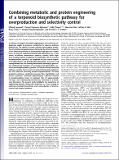Combining metabolic and protein engineering of a terpenoid biosynthetic for overproduction and selectivity control
Author(s)
Parayil Kumaran, Ajikumar; Leonard, Effendi; Prather, Kristala L. Jones; Stephanopoulos, Gregory; Xiao, Wen-Hai; Tidor, Bruce; Mo, Jeffrey David; Thayer, Kelly Marie; ... Show more Show less
DownloadTidor_Combining metabolic.pdf (1.087Mb)
PUBLISHER_POLICY
Publisher Policy
Article is made available in accordance with the publisher's policy and may be subject to US copyright law. Please refer to the publisher's site for terms of use.
Terms of use
Metadata
Show full item recordAbstract
A common strategy of metabolic engineering is to increase the endogenous supply of precursor metabolites to improve pathway productivity. The ability to further enhance heterologous production of a desired compound may be limited by the inherent capacity of the imported pathway to accommodate high precursor supply. Here, we present engineered diterpenoid biosynthesis as a case where insufficient downstream pathway capacity limits high-level levopimaradiene production in Escherichia coli. To increase levopimaradiene synthesis, we amplified the flux toward isopentenyl diphosphate and dimethylallyl diphosphate precursors and reprogrammed the rate-limiting downstream pathway by generating combinatorial mutations in geranylgeranyl diphosphate synthase and levopimaradiene synthase. The mutant library contained pathway variants that not only increased diterpenoid production but also tuned the selectivity toward levopimaradiene. The most productive pathway, combining precursor flux amplification and mutant synthases, conferred approximately 2,600-fold increase in levopimaradiene levels. A maximum titer of approximately 700 mg/L was subsequently obtained by cultivation in a bench-scale bioreactor. The present study highlights the importance of engineering proteins along with pathways as a key strategy in achieving microbial biosynthesis and overproduction of pharmaceutical and chemical products.
Date issued
2010-07Department
Massachusetts Institute of Technology. Department of Chemical Engineering; Massachusetts Institute of Technology. Department of Electrical Engineering and Computer ScienceJournal
Proceedings of the National Academy of Sciences
Publisher
National Academy of Sciences
Citation
Leonard, E. et al. “Combining Metabolic and Protein Engineering of a Terpenoid Biosynthetic Pathway for Overproduction and Selectivity Control.” Proceedings of the National Academy of Sciences 107.31 (2010): 13654–13659. © 2010 National Academy of Sciences.
Version: Final published version
ISSN
0027-8424
1091-6490